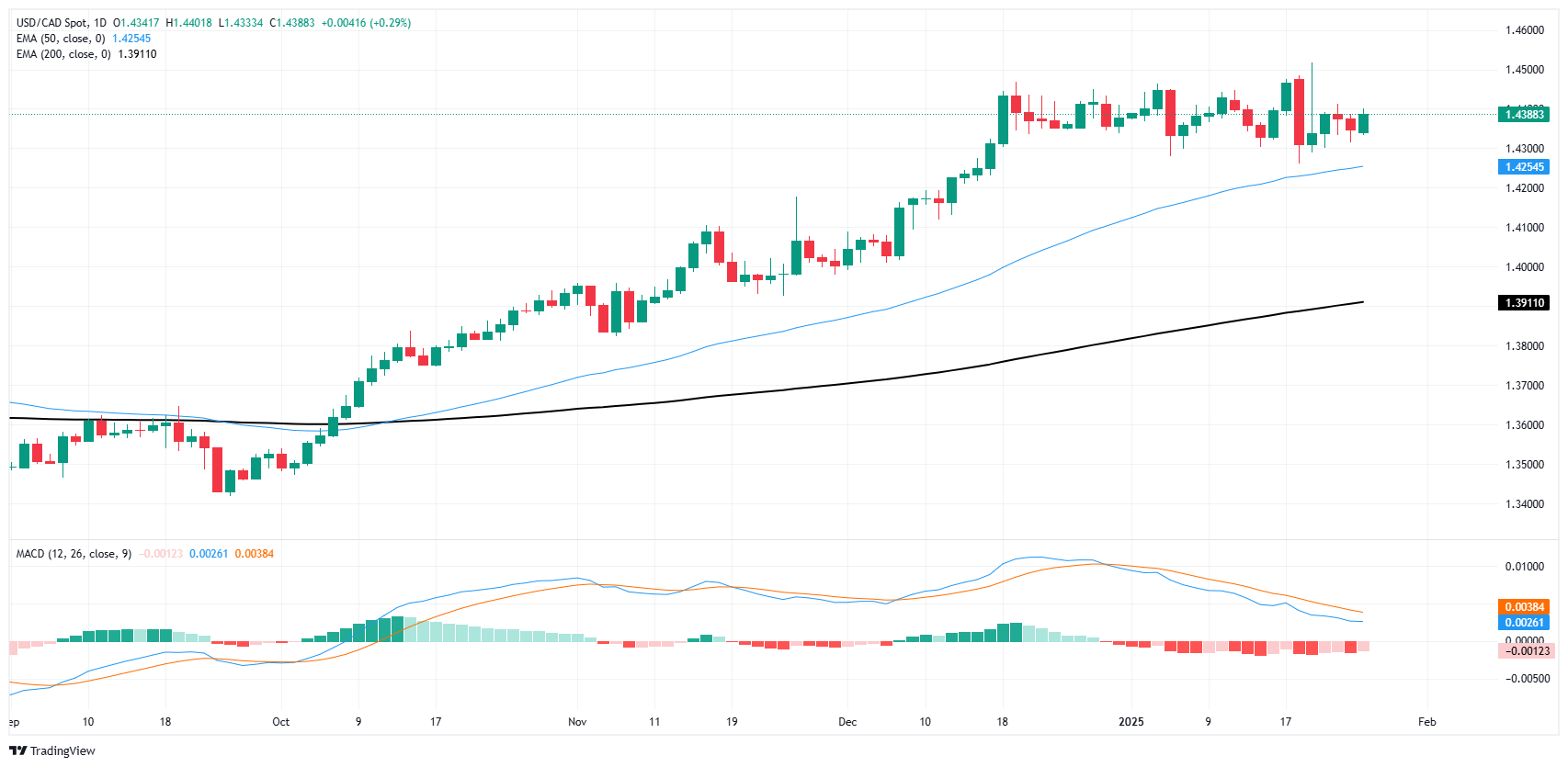Canadian Dollar eases on Monday as BoC rate call looms ahead
- The Canadian Dollar shed 0.3% on Monday as Loonie flows dry up.
- The Bank of Canada is due to cut interest rates again later this week.
- Little else is on the economic data docket to drive the Loonie this week.
The Canadian Dollar (CAD) fell back once again into familiar consolidation against the US Dollar (USD) on Monday, shedding a recently-gained one-third of one percent and continuing to send the USD/CAD pair on a sideways grind around the 1.4400 handle.
The Bank of Canada (BoC) will be delivering its latest rate call later this week, and the Canadian central bank is broadly forecast to deliver another 25 bps rate cut. Even this is still going to be cast within the lens of Greenback moves: the Federal Reserve (Fed) is due for its own rate cut, slated to release within hours of the BoC rate call.
Daily digest market movers: Canadian Dollar continues to grind through consolidation
- The Canadian Dollar fell 0.3% on Monday, pushing USD/CAD back up toward 1.4400.
- BoC is widely expected to cut interest rates by a quarter of a point.
- Fed is forecast to hold rates steady.
- Despite the Fed’s expected hold, markets are expecting more rate cuts from the Fed this year than before.
- The CME’s FedWatch Tool shows rate traders pricing in a total of 50 bps in Fed rate cuts through 2025.
Canadian Dollar price forecast
The Canadian Dollar just can’t catch a break, continuing to grind between key technical handles and keeping USD/CAD chart prints hobbled between 1.4400 and 1.4300. The pair has ground through chart paper in a sideways pattern since mid-December, and momentum remains absent from the pair despite the Loonie routinely testing multi-year lows against the Greenback.
A rising 50-day Exponential Moving Average (EMA) testing into 1.4250 is pricing in a technical floor beneath price action, limiting Loonie bulls’ options for a runaway CAD bid to pick up speed. On the high side, 1.4500 remains the key level for Greenback bidders to beat, though even CAD sellers are struggling to justify the excessively high USD/CAD bids.
USD/CAD daily chart
Canadian Dollar FAQs
The key factors driving the Canadian Dollar (CAD) are the level of interest rates set by the Bank of Canada (BoC), the price of Oil, Canada’s largest export, the health of its economy, inflation and the Trade Balance, which is the difference between the value of Canada’s exports versus its imports. Other factors include market sentiment – whether investors are taking on more risky assets (risk-on) or seeking safe-havens (risk-off) – with risk-on being CAD-positive. As its largest trading partner, the health of the US economy is also a key factor influencing the Canadian Dollar.
The Bank of Canada (BoC) has a significant influence on the Canadian Dollar by setting the level of interest rates that banks can lend to one another. This influences the level of interest rates for everyone. The main goal of the BoC is to maintain inflation at 1-3% by adjusting interest rates up or down. Relatively higher interest rates tend to be positive for the CAD. The Bank of Canada can also use quantitative easing and tightening to influence credit conditions, with the former CAD-negative and the latter CAD-positive.
The price of Oil is a key factor impacting the value of the Canadian Dollar. Petroleum is Canada’s biggest export, so Oil price tends to have an immediate impact on the CAD value. Generally, if Oil price rises CAD also goes up, as aggregate demand for the currency increases. The opposite is the case if the price of Oil falls. Higher Oil prices also tend to result in a greater likelihood of a positive Trade Balance, which is also supportive of the CAD.
While inflation had always traditionally been thought of as a negative factor for a currency since it lowers the value of money, the opposite has actually been the case in modern times with the relaxation of cross-border capital controls. Higher inflation tends to lead central banks to put up interest rates which attracts more capital inflows from global investors seeking a lucrative place to keep their money. This increases demand for the local currency, which in Canada’s case is the Canadian Dollar.
Macroeconomic data releases gauge the health of the economy and can have an impact on the Canadian Dollar. Indicators such as GDP, Manufacturing and Services PMIs, employment, and consumer sentiment surveys can all influence the direction of the CAD. A strong economy is good for the Canadian Dollar. Not only does it attract more foreign investment but it may encourage the Bank of Canada to put up interest rates, leading to a stronger currency. If economic data is weak, however, the CAD is likely to fall.


